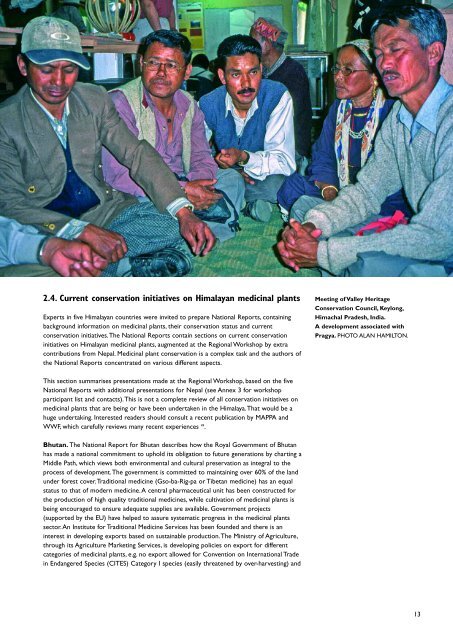<strong>Identification</strong> <strong>and</strong> <strong>Conservation</strong> <strong>of</strong> <strong>Important</strong> <strong>Plant</strong> <strong>Areas</strong> for Medicinal <strong>Plant</strong>s in the Himalayacollection; <strong>and</strong> open access tenure regimes which mitigate against taking much care forthe future. It has been calculated that 36% by volume <strong>and</strong> 51% by value <strong>of</strong> the totalcommercial harvest <strong>of</strong> medicinal plants in Nepal is undertaken destructively 6 .Collection pressure is not uniform across the Himalaya. It is very high in Nepal <strong>and</strong>Uttaranchal, but reportedly less intense in Ladakh, Spiti <strong>and</strong> the eastern Himalaya <strong>of</strong>India 32, 34 . Inaccessibility has saved some places.There was little commercial trade inmedicinal plants from the remote Dolpa area <strong>of</strong> Nepal prior to the building <strong>of</strong> anairport at Juphal in the early 1990s, an event that triggered its expansion 18 .Ephedra geri<strong>and</strong>iana Wall. ex Stapf atLangbushe Solukhumbe. PHOTO KKSHRESTHA (ESON)There are substantial political <strong>and</strong> socio-economic contrasts between the Himalayancountries, <strong>of</strong>ten with major socio-economic changes in recent years.These have majorimplications for medicinal plants, which are only briefly discussed here. Both China <strong>and</strong>India have shifted towards more open market economies since 1990, which has greatlymagnified the commercial pressures on wild medicinal plants, just as was the case withthe demise <strong>of</strong> centrally planned economies in eastern Europe 35 .The one-child policy inChina has likely had a significant impact on reducing dem<strong>and</strong>s on natural resources,compared with what would otherwise have been the case.This is unparalleled elsewherein the region (though minorities in China, including most <strong>of</strong> the indigenous inhabitants <strong>of</strong>the Himalayas, are not subject to this policy). Bhutan is unique for its environmentallyfriendly policies <strong>and</strong> has escaped the high degree <strong>of</strong> deforestation apparent in someneighbouring Himalayan states. Nepal <strong>and</strong> parts <strong>of</strong> the Eastern Himalaya <strong>of</strong> India havesuffered serious insurgencies in recent years, limiting the authority <strong>and</strong> ability <strong>of</strong> thestate to manage natural resources in some regions.Governments in the Himalayan region have found it difficult to enforce rules <strong>and</strong>regulations relating to medicinal plants. It is estimated that less than 5 per cent <strong>of</strong> thelarge quantities <strong>of</strong> medicinal plants exported from Nepal to India is <strong>of</strong>ficially recorded 6 .The ruggedness <strong>of</strong> the Himalaya <strong>and</strong> the low levels <strong>of</strong> staffing <strong>of</strong> line agencies makeforest reserves <strong>and</strong> protected areas very difficult to police. Reportedly, 80% <strong>of</strong> the 75protected areas in the Indian Himalaya suffer from encroachment 32 .There have been substantial declines in traditional knowledge about Himalayan medicinalplants over the last 50 years 15, 34, 36 .This is a serious matter for conservation, astraditional knowledge forms an obvious basis from which to develop modernconservation strategies. In China, a factor contributing to cultural loss has been effortsto ‘modernize’ Traditional Chinese Medicine,Tibetan Medicine <strong>and</strong> other ethnomedicaltraditions 28 . In a related vein, traditional, more nature-friendly methods <strong>of</strong> managingmedicinal plants in the Himalaya have tended to become eroded through social change 19,37-39. One reason is that their frequent legal replacement by state controls which haveproved ineffective 21, 25, 40 . Fortunately, elements <strong>of</strong> customary management sometimesremain, limiting the damage 15, 41 .Climate change is a threat to many medicinal plants in the Himalaya.TheIntergovernmental Panel on Climate Change has indicated that global warming will beparticularly pronounced at high altitudes, especially at lower latitudes (as the Himalaya).Warming is predicted to be 3-5 times faster than elsewhere 32 .12
<strong>Identification</strong> <strong>and</strong> <strong>Conservation</strong> <strong>of</strong> <strong>Important</strong> <strong>Plant</strong> <strong>Areas</strong> for Medicinal <strong>Plant</strong>s in the Himalaya2.4. Current conservation initiatives on Himalayan medicinal plantsExperts in five Himalayan countries were invited to prepare National Reports, containingbackground information on medicinal plants, their conservation status <strong>and</strong> currentconservation initiatives.The National Reports contain sections on current conservationinitiatives on Himalayan medicinal plants, augmented at the Regional Workshop by extracontributions from Nepal. Medicinal plant conservation is a complex task <strong>and</strong> the authors <strong>of</strong>the National Reports concentrated on various different aspects.Meeting <strong>of</strong> Valley Heritage<strong>Conservation</strong> Council, Keylong,Himachal Pradesh, India.A development associated withPragya. PHOTO ALAN HAMILTON.This section summarises presentations made at the Regional Workshop, based on the fiveNational Reports with additional presentations for Nepal (see Annex 3 for workshopparticipant list <strong>and</strong> contacts).This is not a complete review <strong>of</strong> all conservation initiatives onmedicinal plants that are being or have been undertaken in the Himalaya.That would be ahuge undertaking. Interested readers should consult a recent publication by MAPPA <strong>and</strong>WWF, which carefully reviews many recent experiences 49 .Bhutan. The National Report for Bhutan describes how the Royal Government <strong>of</strong> Bhutanhas made a national commitment to uphold its obligation to future generations by charting aMiddle Path, which views both environmental <strong>and</strong> cultural preservation as integral to theprocess <strong>of</strong> development.The government is committed to maintaining over 60% <strong>of</strong> the l<strong>and</strong>under forest cover.Traditional medicine (Gso-ba-Rig-pa or Tibetan medicine) has an equalstatus to that <strong>of</strong> modern medicine.A central pharmaceutical unit has been constructed forthe production <strong>of</strong> high quality traditional medicines, while cultivation <strong>of</strong> medicinal plants isbeing encouraged to ensure adequate supplies are available. Government projects(supported by the EU) have helped to assure systematic progress in the medicinal plantssector.An Institute for Traditional Medicine Services has been founded <strong>and</strong> there is aninterest in developing exports based on sustainable production.The Ministry <strong>of</strong> Agriculture,through its Agriculture Marketing Services, is developing policies on export for differentcategories <strong>of</strong> medicinal plants, e.g. no export allowed for Convention on International Tradein Endangered Species (CITES) Category I species (easily threatened by over-harvesting) <strong>and</strong>13
















